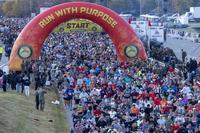Many teens seeking to serve in officer training programs such as the service academies will be required to perform well on the candidate fitness assessment. This test has several events, and a few are not your typical PT testing events. The CFA consists of the following exercises and maximum standards (According to US Naval Academy CFA instructions)
- Ball throw
- Pull-ups
- Shuttle run
- Crunches
- Push-ups
- 1-Mile
Here is a typical question coming from a high school student who is applying her senior year to the Naval Academy and must submit this test soon (typically fall of a high school student's senior year):
Dear Mr. Smith,
This summer, I attended the Naval Academy's Summer Seminar and got a chance to meet you after the morning PT session you led. I have been seriously training for the CFA; however, I have been struggling with pull-ups and push-ups. Are there any workouts or programs you would recommend? I am doing well on all other events of the Candidate Fitness Assessment (CFA) – sit-ups, shuttle run, 1-mile run, ball throw.
Thank you for your time.
Sincerely, Ally
Ally, this is a common question. Even though you asked about only the push-ups and pull-ups, you have to keep practicing all the other elements, as the test itself can make exercises more difficult when put together in a max-effort circuit.
Yes, the push-ups can be affected by previously run exercises, especially two-minute tests and sprints. The pull-ups, however, are essentially the first tough exercise of the test. You need to get good at them, but also the following events afterward. Here is a complete breakdown for you, with references and links on more information to read on testing event specifics.
Basketball throw: This is, by far, one of those exercises that many people have asked, “Why?” When I was stationed at the Naval Academy Physical Education Department as an instructor, one of the creators of that test, Coach Ed Peery, answered my question. “It measures athletic potential.”
Hearing that from a coach who had been at the Naval Academy for nearly 40 years was like hearing Yoda say it, and I have questioned it no more. So you need to practice it and build shoulder strength by doing pull-ups, push-ups, dips, overhead presses, lightweight shoulder workouts and throwing. Those who do best on this test are throwing athletes (quarterbacks, pitchers, water-polo players, etc.). So practice a few times every day and work on your technique.
Pull-ups: Practice more pull-ups and get your arms used to pulling your body weight. Hanging from the bar, doing negative pull-ups, jumping pull-ups and building your muscle endurance to handle more pulling is the key. See Major Posey’s Pull-up Method that she teaches women of the Marine Corps to do 10-20 pull-ups. Secondary exercises are rowing machines, dumbbell rows, pulldowns and biceps curls.
Shuttle run: The 120-foot shuttle run is over just about as quick as it started. The goal here is to run 10 yards (30 feet) four times as quickly as you can. Work on your starts by doing squats and jumps in your workout. And work on your technique of changing direction every 10 yards.
Review short-shuttle runs and notice how they pivot and get into a three-point stance every change of direction to enhance their starts every 10 yards. Even though this is a test that averages only 7-9 seconds, it has the capability of consuming a lot of energy when done twice.
Crunches: A two-minute test of crunches is challenging and requires some practice if you want to come near the maximum effort. Out of all the events, this is one where a little practice pays huge dividends. For instance, if you strive to get 90-100 in two minutes, you need to practice 45-50 in one-minute sets and 22-25 in 30-second sets. Starting off too fast can kill the ability to maintain the pace for a solid two minutes, so learn the pace.
Push-ups: I like to mix pull-ups, push-ups and crunches into a single workout. such as the PT Pyramid, Super Set or Max Rep Set workout options. You can do any or all of them each week, but it is recommended to do these exercises every other day for three times a week to see the best results. You cannot do them once a week or less and expect to see your muscle stamina improve. Sure these measure upper-body strength when doing a few, but doing 20 pull-ups, 100 push-ups and crunches require you to turn a strength exercise into an endurance exercise.
1-mile run: This is considered a sprint, not a jog. To get anywhere near the maximum score requires you to put out hard and learn the pace. One way to do that is to master a goal pace on quarter- and half-mile intervals. For instance, if you want to run a six-minute mile, do 1:30 quarter-miles and three-minute half-miles. See more about Training for Timed Runs.
Be in shape for the entire test. Do not just practice a few events that you are not very good at doing and hope everything fits nicely on test day. Practice the test a few more times before actually being tested on it to learn a strategy for taking the test and pacing yourself when needed.
Stew Smith is a former Navy SEAL and fitness author certified as a Strength and Conditioning Specialist (CSCS) with the National Strength and Conditioning Association. Visit his Fitness eBook store if you’re looking to start a workout program to create a healthy lifestyle. Send your fitness questions to stew@stewsmith.com.
Want to Learn More About Military Life?
Whether you're thinking of joining the military, looking for fitness and basic training tips, or keeping up with military life and benefits, Military.com has you covered. Subscribe to Military.com to have military news, updates and resources delivered directly to your inbox.
















